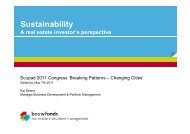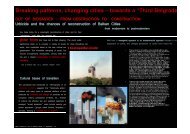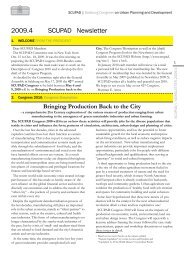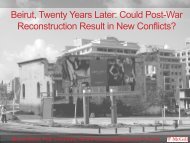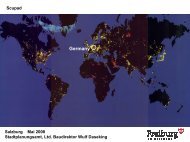Presentation - SCUPAD
Presentation - SCUPAD
Presentation - SCUPAD
You also want an ePaper? Increase the reach of your titles
YUMPU automatically turns print PDFs into web optimized ePapers that Google loves.
Rapidly expanding city in urbanizing World<br />
The Case of<br />
Aleppo<br />
Dr. Fatina Kourdi<br />
University of Aleppo – Syria<br />
Austria - Vienna - Salzburg<br />
10 – 14 May 2006<br />
2
The characteristic of the present urban<br />
development in the Middle East in general is<br />
dominated through the rapidly growth of cities,<br />
to become a metropolis. The population of these<br />
metropolis grew strongly during the last half of<br />
the 20th century.<br />
3
Syria<br />
is one of this example. The country located in a<br />
region which considered to be the place of the<br />
birth of urban development, with a history of<br />
more than 5000 years.<br />
The variety of cultural heritage in the country is<br />
reflected in urban development and in the<br />
economic life of the country.<br />
Even the influence of the occident affected the<br />
cityscape in the last 150 years.<br />
4
Syria faces since Its independence in 1945<br />
a comprehensive changes.<br />
In general, the country ought to be modernised step<br />
by step. Liberalisation of trade is still the<br />
characteristic of the economy, activating the<br />
private sector, as well as the use of capital<br />
investments from foreign countries are therefore<br />
important elements.<br />
Syria, a central organized state, supports in<br />
particular the two metropolis Damascus &Aleppo. 5
Damascus and Aleppo<br />
The population of these metropolis grew strongly<br />
during the last half of the 20th century. The main<br />
reasons are:<br />
general surplus of births (2.5%),<br />
massive immigration from the country side<br />
and from the small cities to these metropolis<br />
domestic migrations of minorities and a<br />
rising immigration of foreigners.<br />
6
Syria growth since 1960<br />
20000<br />
18000<br />
16000<br />
14000<br />
12000<br />
10000<br />
8000<br />
6000<br />
4000<br />
2000<br />
0<br />
2005<br />
1994<br />
1981<br />
1970<br />
1960<br />
7
Aleppo<br />
8
It is difficult to find a city like Aleppo in which<br />
economical and architectural activities joined together<br />
for thousands of years.<br />
Aleppo was conquered by many civilizations which left<br />
their traces in the urban and architectural character of<br />
the city.<br />
Aleppo was inhibited by different nationalities that<br />
belong to three religions. They lived harmoniously with<br />
each other and cooperated to improve living conditions.<br />
The City was always able to keep in touch with the<br />
external world. It both influenced it and was influenced<br />
by it. This is due to the ability of its population to<br />
9<br />
communicate with it.
Aleppo<br />
The city was and still an<br />
important centre of<br />
trade and industry<br />
between east and west,<br />
commercial and<br />
industrial activities,<br />
trade, arts and crafts,<br />
making the city<br />
attractive.<br />
Aleppo's Old City is one<br />
of the biggest and best<br />
conserved Islamic old<br />
cities. Its urban entity<br />
of traditional is unique<br />
in the world .<br />
14
Aleppo<br />
Aleppo is now the<br />
largest city in the<br />
country with<br />
around<br />
2.5m inhabitants,<br />
with rapidly<br />
growing about<br />
50,000 additional<br />
people each year.<br />
16
SYRIAN POPULATION DISTRIPUTION BY GOVERONERATE,<br />
ACCORDING TO CIVIL REGISTRATION RECORD IN . 1 / 1 / 2005<br />
Dar ' a<br />
%4<br />
Al-Sweida<br />
Al-Rakka %2<br />
%4<br />
Al-Hasakeh<br />
%6<br />
Idleb<br />
%8<br />
Deir-ez-Zor<br />
%7<br />
Lattakia<br />
%5<br />
69<br />
Tartous<br />
%4<br />
Quneitra<br />
%2<br />
Hama<br />
%9<br />
Damascus<br />
%8<br />
Homs<br />
%9<br />
Damascus; 7.8<br />
Damascus Rural '<br />
%8<br />
Aleppo<br />
%24<br />
Aleppo; 23.5<br />
Nearly the quarter of<br />
Syrian's population<br />
lives in Aleppo<br />
Aleppo<br />
Homs<br />
Damascus –city<br />
Damascus-rural<br />
23.5%<br />
9%<br />
7.8%<br />
8%<br />
17
How did Aleppo grow during the last century?<br />
• Modernization of state started in ottoman empire in the<br />
middle of 19 century, which was reflected on the growth<br />
of cities. Several legality were develop Corresponding to<br />
this aim.<br />
• 1877 the first municipality in Aleppo was established<br />
• 1883 the first law has dealt with dividing and organizing<br />
the lands for building<br />
• The growth of Aleppo can be classified into 4 stages :<br />
• 1860 – 1920<br />
• 1920 – 1946<br />
• 1946 – 1980<br />
18<br />
• 1980 – 2005
1860 – 1920<br />
By 1900 , the City of Aleppo included approximately 100,000<br />
inhabitants, including the suburbs which had developed outside<br />
the main gates since the 16 century.<br />
19
• In the late 19th century,<br />
the European influence<br />
started to be evident in the<br />
architectural design of the<br />
city.<br />
• The city started<br />
expanding westward<br />
where modern residential<br />
European-styled quarters<br />
were constructed, which<br />
clearly reflected<br />
contemporary European<br />
town-planning influences.<br />
20
1920 – 1946<br />
• 1899 the first master plan was<br />
prepared by the German<br />
planner Jung, which directed<br />
the expanding of the city<br />
towards west,<br />
• In 1920 The city was provided<br />
with a train station ( Baghdad<br />
Station ) The Tram connected<br />
the old city with new quarters,<br />
• The city had a big garden and<br />
wide streets with trees<br />
according the European style .<br />
21
1920 – 1946<br />
During the mandate period<br />
two master plans of the city<br />
were prepared.<br />
• 1932 Dangeit Master plan<br />
• 1935 Icoshar Master plan<br />
The both neglected the old<br />
city as an area with special<br />
characteristic.<br />
The execution of the master<br />
plans caused a physical and<br />
social damage to the old<br />
fabric<br />
22
1920 – 1946<br />
New construction<br />
technologies gave the city new<br />
image<br />
23
1946-1980<br />
After Syria's independence the country<br />
witnessed a major industrial and economical<br />
development, which was reflected mainly in<br />
the growth and expansion of its cities.<br />
25
1946-1980<br />
In Aleppo this<br />
growth necessitated the<br />
transfer of many of the<br />
commercial, financial<br />
and administrative<br />
functions in addition to<br />
residential function<br />
outside the Old City.<br />
26
1946-1980<br />
The population increasing of Aleppo caused by:<br />
• large immigration from country side<br />
• large immigration from smaller city to<br />
Aleppo<br />
A big need of new cheep houses especially for<br />
poor and middle class family, caused through<br />
this immigrations and through the social and<br />
economical change in the form of family which<br />
transfer from nuclear to small family.<br />
27
1946-1980<br />
Massive interventions between 1940 and 1980,<br />
caused by master plans of various European<br />
urban planners, there strategy focused on:<br />
• modernization the city according to<br />
European principles,<br />
• Concentrating on the western part of the city<br />
and ignoring the eastern newly growing part<br />
of the city<br />
1954 Gotten Master plan<br />
1974 Banshoya Master plan<br />
28
• 1954 the state<br />
started to erect new<br />
social housing<br />
projects reflecting<br />
the political regime<br />
which was highly<br />
influenced by the<br />
Socialism.<br />
• In Aleppo this<br />
projects located in<br />
the northern and<br />
eastern part of the<br />
city and were plan<br />
for the poor and<br />
short income class.<br />
31
Implementing of these projects defined<br />
clearly the Segregation line in the city,<br />
which goes from the northern east to the<br />
southern west, dividing the city<br />
depending on the economic factor instead<br />
of traditional factors, which depended on<br />
Religion, Tribe, or family.<br />
34
In spite of several projects, the city<br />
wasn't able to provide the appropriate<br />
residence, to cover the sudden and<br />
rapid increase of the population,<br />
That's force the new inhabitants to do<br />
that illegally in different ways:<br />
35
1- erecting houses inside the administrative city in<br />
the still inbuilt areas<br />
36
2- In the Old City<br />
Subdivision of the existing historical building into smaller units<br />
for different families and adding illegally one, tow or more stors<br />
37
3- In the surroundings protection area, which was often for<br />
agricultural use.<br />
Forming, a “belt of poverty”<br />
38
Aleppo<br />
A city with differnt faces<br />
39
In In the the 16 13<br />
Hellenistic In century In 1980 1930 1900 1850<br />
In 2005<br />
40
1980 - 2005<br />
It’s obvious that the increasing urban expansion Of cities in<br />
Syria is today a common phenomena<br />
this phenomena<br />
reach In Aleppo<br />
its top, the city<br />
has nowadays<br />
more than 2.5<br />
millions, with<br />
density of 275<br />
Person/hectare<br />
Quneitra<br />
0.8<br />
0.0<br />
Tartous<br />
2.1<br />
6.1<br />
Dra`a<br />
5.5<br />
4.1<br />
Al-Sweida<br />
2.6<br />
1.0<br />
Al-rakka<br />
3.1<br />
6.0<br />
Al-hasakeh<br />
4.2<br />
8.9<br />
Idleb<br />
3.8<br />
11.0<br />
4.6<br />
Deir-ezzor<br />
7.0<br />
Lattakia<br />
5.2<br />
4.7<br />
Hama<br />
5.4<br />
10.6<br />
Homs<br />
8.6<br />
8.6<br />
Aleppo<br />
26.9<br />
17.9<br />
Damascus Rural<br />
PERCENTAGE OF POPULATION BY PLACE<br />
OF RESIDENCE ( Urban & Rural) AT MID YEAR 2005<br />
15.3<br />
9.9<br />
Damascus<br />
41<br />
16.2<br />
0.0<br />
30.0<br />
25.0<br />
20.0<br />
15.0<br />
10.0<br />
5.0<br />
0.0
• It’s difficult to Ignore this phenomena<br />
,with its great usage of resources and its<br />
negative environmental impact .<br />
• This Problem is today one of the most<br />
important issue and task for the local<br />
authorities and municipality, especially<br />
after the adapting of 21 Agenda with its<br />
goal the “sustainable development” .<br />
42
This phenomena began at the end of sixties of last century, and<br />
grew rapidly since that day until now, reaching its top in the<br />
nineties of the twentieth century .<br />
4,600,000<br />
4,400,000<br />
4,200,000<br />
4,000,000<br />
3,800,000<br />
3,600,000<br />
3,400,000<br />
3,200,000<br />
3,000,000<br />
2,800,000<br />
2,600,000<br />
2,400,000<br />
2,200,000<br />
2,000,000<br />
1,800,000<br />
1,600,000<br />
1,400,000<br />
small cities<br />
1,200,000<br />
1,000,000<br />
country side<br />
Aleppo's city<br />
greater Aleppo<br />
2004<br />
1994<br />
1981<br />
1970<br />
1960<br />
800,000<br />
600,000<br />
400,000<br />
200,000<br />
0<br />
43
Illegal settlement -Facts and figures<br />
1958<br />
1981 1994<br />
Total<br />
Legal<br />
illegal<br />
1958<br />
2200<br />
1800<br />
400<br />
1981<br />
4900<br />
3500<br />
1400<br />
1994<br />
7300<br />
5200<br />
2100<br />
2005<br />
9200<br />
5700<br />
3500<br />
2006, Aleppo, as the<br />
fastest growing city has:<br />
2.5 millions inhabitants<br />
More than 60% of its<br />
population live in about<br />
35% of total area<br />
44
Illegal settlement -Facts and figures<br />
22 illegal areas<br />
surrounding the<br />
city mostly from<br />
the southern,<br />
eastern and<br />
northern.<br />
45
easons of uncontrolled growth of Aleppo<br />
• The absence of regional planning.<br />
• The inflexibility of master plans to correspond to the<br />
changeable socio - economic conditions .<br />
• some legalese which enlarged the problem (the renting<br />
law, the law /60/ which stopped the operations of<br />
equipping the lands for housing uses which led to<br />
increasing the prices of lands prepared for construction)<br />
• The eccentricity in directing the city and the<br />
administrative corruption.<br />
46
The urban<br />
form of the<br />
illegal<br />
settlement<br />
ensure that<br />
it follows a<br />
clear system<br />
managed by<br />
(land mafia)<br />
The Mafia<br />
bought the<br />
farms and<br />
planed it as a<br />
residential<br />
area for the<br />
new<br />
immigrants.<br />
47
The farm was divided into plots prepared for building houses<br />
neglecting other functions needed (infrastructure, streets, green<br />
areas , and other social services, schools health points….) 48
• The house typology of the illegal house reflects the socioeconomical<br />
condition of the family ,<br />
• The house forms the urban unit in the illegal agglomeration<br />
• This form change step by step as following<br />
– selling form, one room house with open courtyard and<br />
with preliminary sanitary services.<br />
- Horizontal expansion stage: building of one or many<br />
more rooms,with the roofing of courtyard.<br />
- Vertical expansion stage: other stories are added and a<br />
part of the ground floor is taken for commercial or work<br />
shops.<br />
49
• It is wrong to consider these phenomena as a separated<br />
phenomenon which the citizens alone bear its burden.<br />
However, it’s primary a political and economical problem,<br />
• Since the nineties of last century the problem started to be<br />
one of the most important subject for conferences and for<br />
related authorities<br />
• tow years ago the municipality started practically to find<br />
solution for this problem, but all happens with the same<br />
instruments and strategies which foxes on the subject as an<br />
architectural problem in a limited area regardless the<br />
political, economical and administrative reasons.<br />
56
Thank You For Your Attention<br />
57




